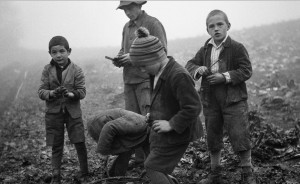The hills were alive with the sounds of children working. From the mid 19th century until very recently poor children were removed from Swiss homes and sent to farms to work. Some children were sent to homes were they clearned house before and after school.
Historians estimate there were hundreds of thousands such children. For one year alone in the 1930s, records show 30,000 children were placed in foster families across Switzerland.
“It’s hard to know precisely how many contract children there were as records were kept locally, and sometimes not at all,” says Loretta Seglias. “Some children were also placed by private organisations, or their own families.”
The extent to which these children were treated as commodities is demonstrated by the fact that there are cases even in the early 20th Century where they were herded into a village square and sold at public auction.
Seglias shows me some photographs. One child looks barely two – surely she couldn’t be a contract child? “She could, she would be brushing floors bringing in the milk. Sometimes they came as babies on to the farms, and the bigger they grew the more work they would do,” Seglias says.
“Children didn’t know what was happening to them, why they were taken away, why they couldn’t go home, see their parents, why they were being abused and no-one believed them,” she says.
“The other thing is the lack of love. Being in a family where you are not part of the family, you are just there for working.” And it left a devastating mark for the rest of the children’s lives. Some have huge psychological problems, difficulties with getting involved with others and their own families. For others it was too much to bear. Some committed suicide after such a childhood.
Social workers did make visits. David Gogniat says his family had no telephone, so when a social worker called a house in the village to announce that she was coming, a white sheet was hung out of a window as a warning to the foster family. On the day of this annual visit David didn’t have to work, and was allowed to have lunch with the family at the table. “That was the only time I was treated as a member of the family… She sat at the table with us and when she asked a question I was too scared to say anything, because I knew if I did the foster family would beat me.”
Today we regard poor children as a social problem. But the lingering idea that the poor alone are responsible for their plight plagues countries around the world to this day.

